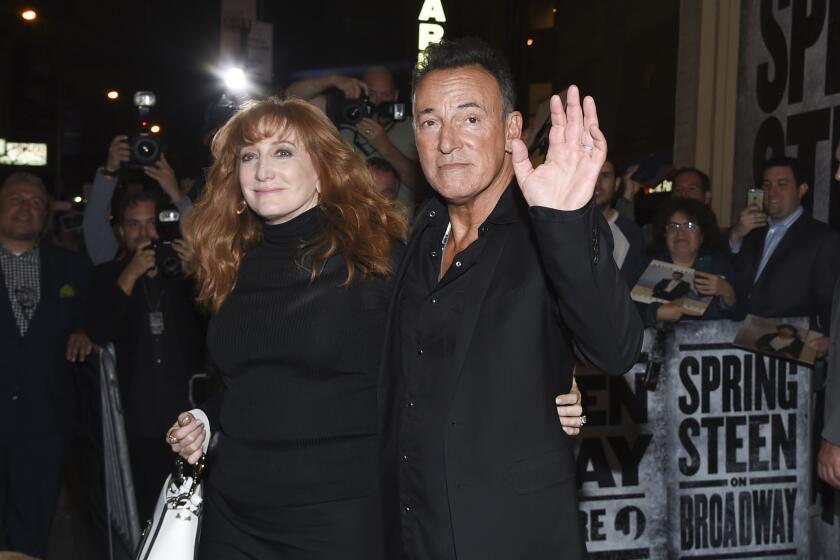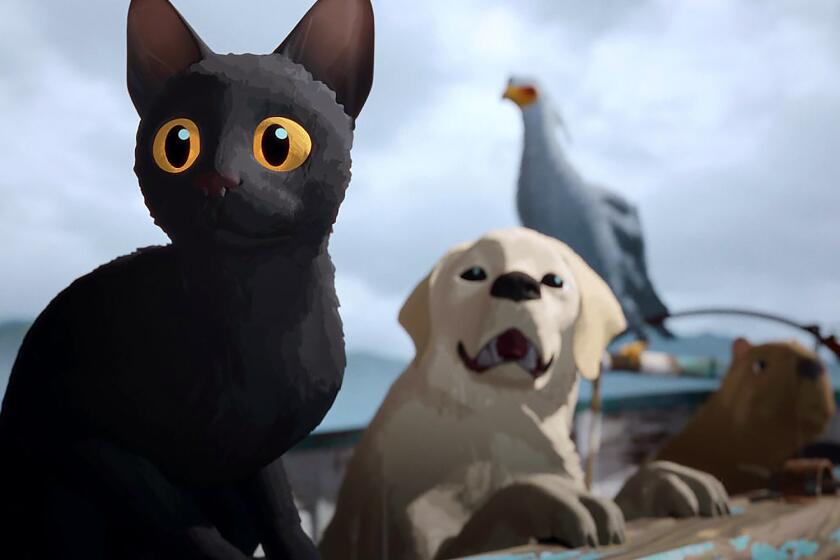Innocent, Patriot, Idealist, Romantic
To lose Robert Mitchum and James Stewart on successive days is a sharply painful reminder that the truly great figures in modern film history--the icons--are a thin and fast-disappearing band. There weren’t that many to begin with, not at the level beyond stardom, and time and circumstance have seen to it that they don’t make them like Stewart and Mitchum anymore. Gregory Peck, Kirk Douglas, Bob Hope, Katharine Hepburn. . . . It’s a lonely Pantheon these days.
Stewart, who died of cardiac arrest at the age of 89 on Wednesday, and Mitchum could not have been more different on screen and off: Stewart out of small-town, solidly middle-class America with a Princeton polish added; Mitchum a vagabond youth from age 12, troubles and odd jobs until, like Stewart, he found his calling as an actor. Both came to glory in the days when movies were the unchallenged mass medium of entertainment, and when the camera (and the audience) liked what it saw, the sky was the limit.
For the record:
12:00 a.m. July 9, 1997 For the Record
Los Angeles Times Wednesday July 9, 1997 Home Edition Calendar Part F Page 8 Entertainment Desk 4 inches; 110 words Type of Material: Correction
Jimmy Stewart--An appreciation of James Stewart in Friday’s Calendar contained several erroneous statements. Stewart did not play a reluctantly heroic newspaper editor in “The Man Who Shot Liberty Valance”; Edmund O’Brien did. Stewart played Ransom Stoddard, an attorney who stubbornly wished to bring order to the West with a lawbook rather than a gun. Neither did his character say, “When the legend becomes fact, print the legend.” That line was uttered by an eastern reporter after Stewart’s character confesses that the legend that launched his political career was a lie. In addition, Stewart’s character in “The Philadelphia Story” was a reporter for Spy magazine, not Life. The title of the 1948 drama Stewart starred in as a contemporary reporter was “Call Northside 777.”
Stewart’s major roles are part of the collective national memory for generations of us: the hoarse-voiced, filibustering idealist collapsing into a pile of supportive telegrams in “Mr. Smith Goes to Washington,” the Life reporter falling for Katharine Hepburn in “The Philadelphia Story” (and playing a marvelous drunk scene with Cary Grant), the small-town banker contemplating suicide in Frank Capra’s classic tear-jerker “It’s a Wonderful Life.”
But there was so much more, including all the westerns. Stewart as the reluctantly heroic newspaper editor in John Ford’s “The Man Who Shot Liberty Valance,” co-starring with John Wayne (another departed icon) and saying, “When the legend becomes fact, print the legend,” a practice that has not disappeared from weekly journalism.
He was a persistent contemporary reporter in “Northside 777,” the heroic clown fighting a tragic circus fire in DeMille’s “The Greatest Show on Earth,” which he did for a reduced salary because he wanted to play the part. He was the duped defense attorney in Otto Preminger’s “Anatomy of a Murder.”
I tip my hat to a forgotten Stewart gem called “Fool’s Parade,” an offbeat western directed by Andrew McLaglen from a script by James Lee Barrett, a sleeper about three ex-cons stalked by their former prison guard that not enough customers woke up to.
If we remember the heavy parts, here was Stewart, a uniquely gifted light comedian, co-starring with an invisible rabbit in “Harvey” so convincingly you could almost see the rabbit.
One film he didn’t make was “The Good Earth.” Unbelievably, he was screen-tested for it. That was because, he told me, “I was the only actor on the lot who looked as though he’d actually been through a famine.” That was Jimmy Stewart: The joke, the gentle joke, was on him.
More than any actor I can think of, the man you saw on the screen was, most often, the man Stewart was, a prototypic American (as Henry Fonda and John Wayne were as well, suggesting the American range) and as Jack Lemmon is in his generation. He was Stewart the innocent, the patriot, the idealist and the ultimate optimist, the romantic, a believer in the small-town virtues on which he was raised. He invited trust and believability.
Talking about acting, he once told me, “The hard parts are easiest; it’s the cardboard parts that are hard to do. How do you make ‘em come alive?”
He was a wonderful, crafty raconteur, and that patented, stammering drawl of his was endearing; it was also in its way as conscious as the drolleries behind which the real Alfred Hitchcock hid. He once explained how his trombone coach on “The Glenn Miller Story” threatened to quit the second day. Even when he was pretending to play, Stewart made a little buzzing sound through the mouthpiece that was driving the trombonist crazy.
“So what, ah, what we did, was cut a little piece of cork and put it in the hole of the mouthpiece so I couldn’t make any sound at all,” he said with satisfaction.
With all his slow-voiced joshing of himself, he was nobody’s fool. It was no small part of his personality and his huge appeal as a star that it was evident his values had stayed intact, untainted by avarice, ego or cynicism, in a Hollywood whose darkest legends seem always to have a grain of truth about them.
The excitement Stewart felt about doing good work did not leave him in the more than 60 years he was at it. He once said, and you knew he meant it, that he felt he was the luckiest man in the world to have become part of the MGM family in its greatest days. After the war he became the first major star to become an independent corporation, but by then the industry was changing swiftly in the television era.
One night a few years ago, James Stewart and I and our wives were at the same table at one of those innumerable Hollywood fund-raising dinners. Neither of us had any function except to be in attendance, and even as those events go this was a supremely tedious night.
I whispered, “What are we doing here?”
“Aw,” Stewart said with an affectionate nod at his wife, “Gloria likes it.”
That said everything about his deep devotion to Gloria, and about one of the most romantic and loving marriages to be found in Hollywood or anyplace else. Since her death in 1994, Stewart, in fragile health at best, had become an almost total recluse, surrounded by the affection of children and grandchildren (and fans who continued to write him).
It is sentimental to say so, but I suspect it is not wrong to guess that Jimmy Stewart, a devout Presbyterian with a belief in the life beyond, was waiting to rejoin Gloria. And, whatever one’s own beliefs are, it is impossible not to wish the reunion for so good and deserving a man.
More to Read
Only good movies
Get the Indie Focus newsletter, Mark Olsen's weekly guide to the world of cinema.
You may occasionally receive promotional content from the Los Angeles Times.










